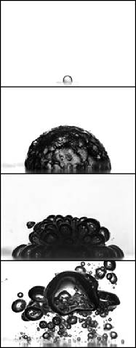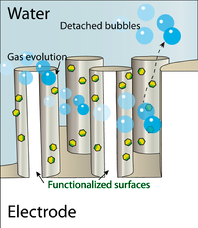1Early diagnostics of diseases, chaired by prof.dr.ing. Guus Rijnders
2Unconventional electronics, chaired by prof.dr.ir. Wilfred van der Wiel
3Storage of renewable energy, chaired by prof.dr. Guido Mul
4Science for security, chaired by prof.dr. Pepijn Pinkse
Storage of renewable energy
Chair: Guido Mul
INTRODUCTION
Renewable energy will increasingly contribute to the energy demand of the world society, which is projected to grow to 20 TW in 2020. A problem of various renewable sources is their intermittency in supply (e.g. wind speed, day-night or summer-winter cycles). To balance supply and demand, existing technologies need to be significantly improved, or new technologies developed, to store renewable energy in times when supply exceeds demand, and which can easily be made available in times when demand exceeds supply.
This session will give a (limited) overview of research activities in the MESA+ institute focused on energy storage. The audience is stimulated to be inspired by the presentations and to contribute to the discussions, as well as to provide novel ideas for energy storage on the basis of their own research activities. This includes identifying funding opportunities for energy storage-related research. The program of this session is as follows.
Program
14.00 | Introduction by Guido Mul. overview of renewable energy sources and |
14.15 | Mark Huijben (IMS) 3D Solid-state batteries |
14.30 | Leon Lefferts (CPM) Plasmas and catalysis for renewable energy storage |
14.45 | Michiel van Limbeek (POF) Evaporation and Energy |
15.00 | David Fernandez Rivaz (MCS) Valorization of solar hydrogen |
15.15 | Discussion |
ABSTRACTS
3D Solid-state batteries – Mark Huijben (Inorganic Materials Sciences)
Most commercial rechargeable lithium-ion batteries deliver energy densities of only 10-15% of their theoretical values. The key problems determining this limitation are the slow electrode process kinetics, low ionic diffusion and low electronic conductivity, particularly at the electrode-electrolyte interfaces. Mastering control of these interfaces is identified as a grand challenge in battery research, even more important than designing new electrode or electrolyte materials. Our goal is to realize self-assembled 3D solid-state batteries with improved volumetric energy densities through controlled interface engineering. To achieve this we study and exploit nano-architecting of 3D electrolyte-electrode structures to control the individual crystal structures of the nanopillars, matrix and their interfaces, in order to achieve enhanced interfacial properties for lithium diffusion. The realization of such electrode/electrolyte nanocomposites, through self-assembly from two immiscible oxide materials, will provide a simple fabrication process, which will enable the direct transfer from small lab-scale devices to large industry-scale battery applications. The fundamental issue is explored to what extent the volumetric energy density can be enhanced by diminishing the diffusion length in 3D structures. Such nanometer-sized building blocks will eliminate the current limitations for the lithium-ion flux (output power and charging rate) in batteries.
Plasmas and catalysis for renewable energy storage – Leon Lefferts (Catalytic Processes and Materials)
One way to convert excess electricity to chemical energy is via activating molecules in a plasma. We will shortly discuss the energy efficiency of plasmas, and how catalysis might help in achieving energy efficient conversion of e.g. CO2. Also analysis of the mechanisms at the molecular level of plasma associated catalysis will be addressed, as well as some reactor concepts and configurations.

Bubbles and Energy – Detlef Lohse (Physics of Fluids)
Gas and vapor bubbles have various applications in energy related issues in science and technology, from electrolysis, to catalysis, to boiling. However, many phenomena are not yet understood. In this talk some bubbly issues will be reviewed with which we deal in the context of energy. The photographs below show a vaporising droplet on a superheated surface, giving an idea on the beauty and complexity of the process.

Valorization of Solar Hydrogen – David Fernandez Rivas (Mesoscale Chemical Systems) In this talk I will provide some examples of what is the experience of a particular line of research around i) the design, ii) the construction of a microfluidic demonstrator, and iii) the risks in trying to deploy the scientific results into a society that is constantly looking for cleaner and smarter ways to create hydrogen. Some of the challenges related to the fluid and mass transport, as well as its interconnection with the technology available will be covered. For example, how can we make sure that the electrode surfaces are not only efficient in capturing the sunlight, but also support the catalyst needed to evolve hydrogen? Also, what if we already have formed that precious hydrogen bubble and it attaches strongly to the electrode surface, limiting the efficiency of hydrogen production? These challenges are very relevant for the device architecture for solar hydrogen production, which has not been defined yet. Further, the pathways toward commercialization taking into account environmentally friendly materials and processes, as well as its societal embedding have not been clarified. Some attention will also be given to these aspects. |
|

